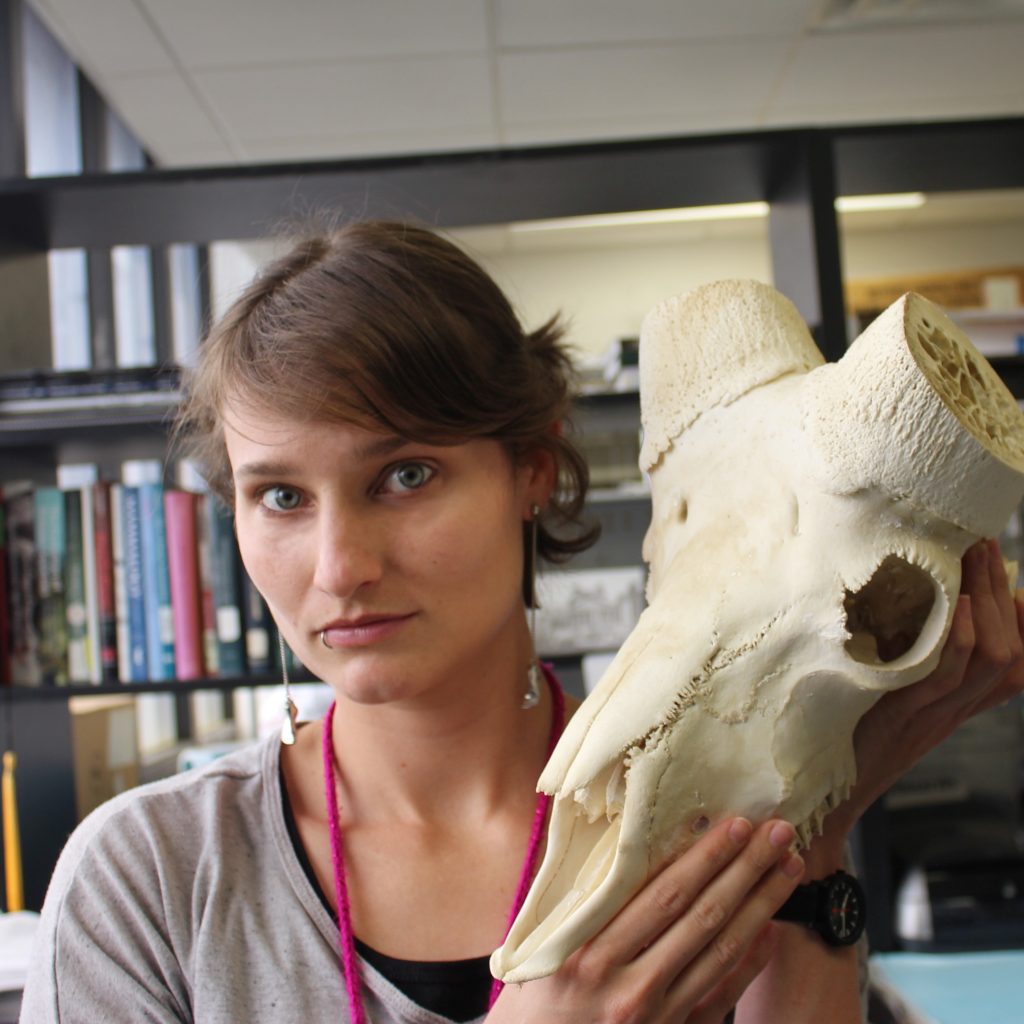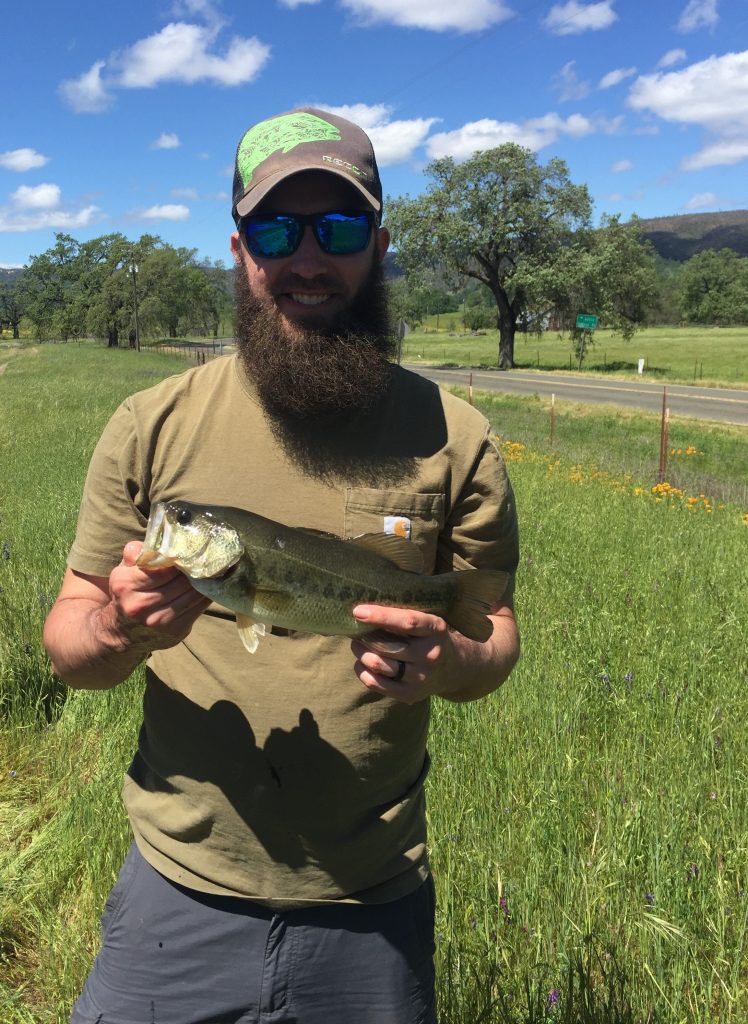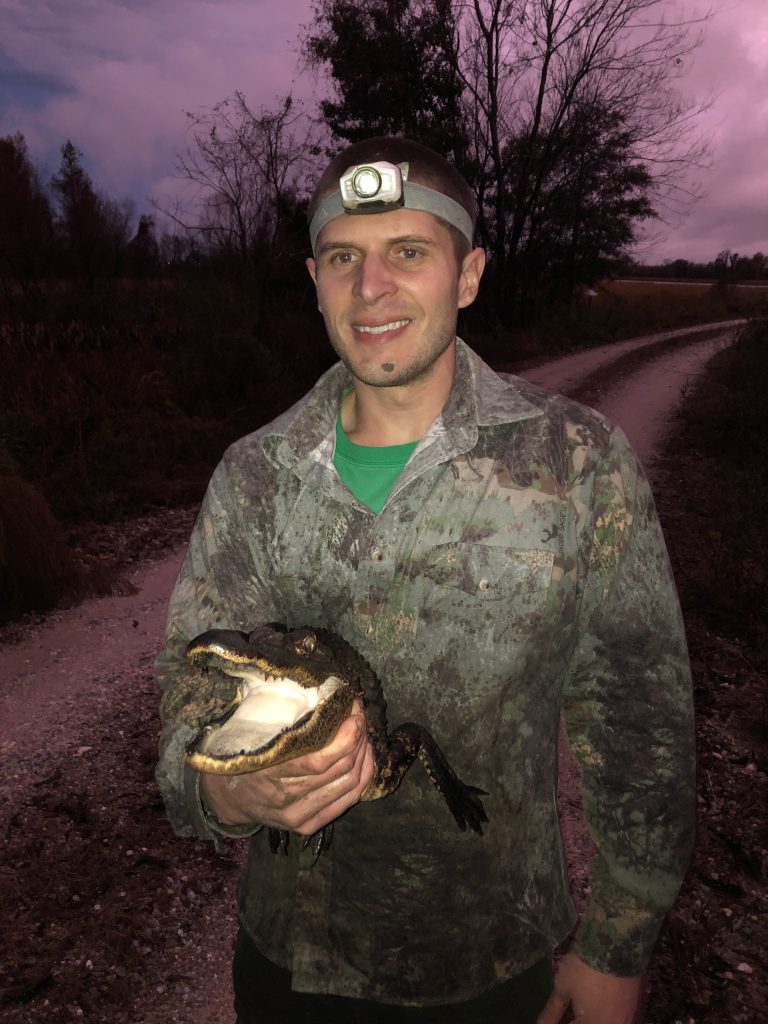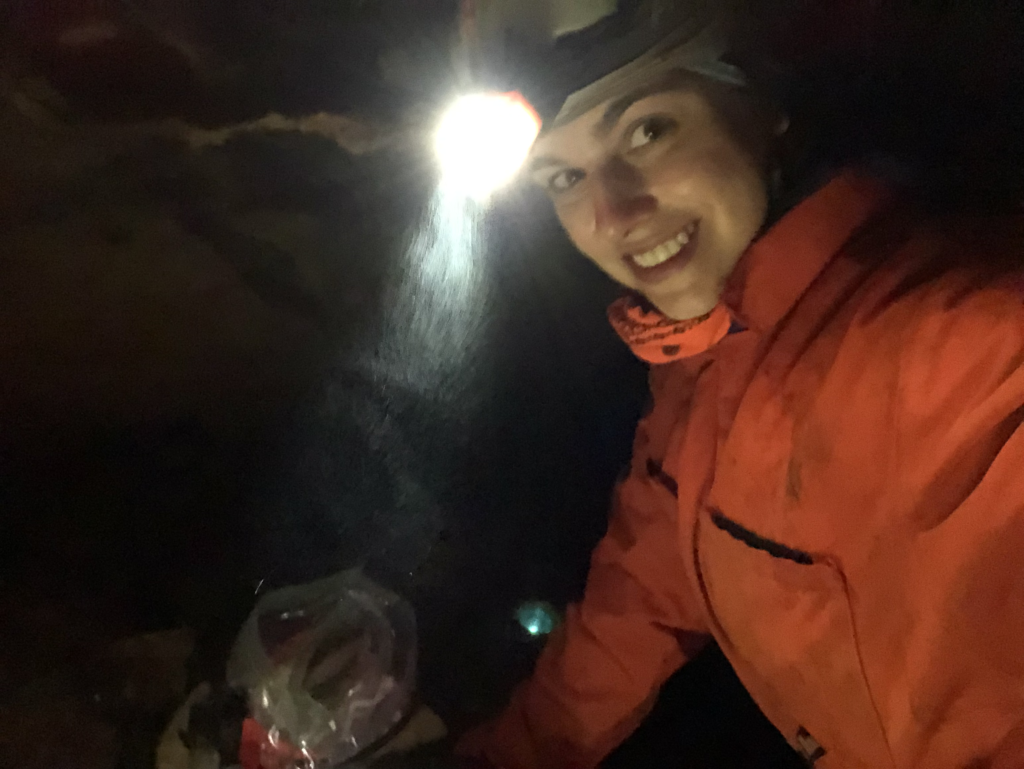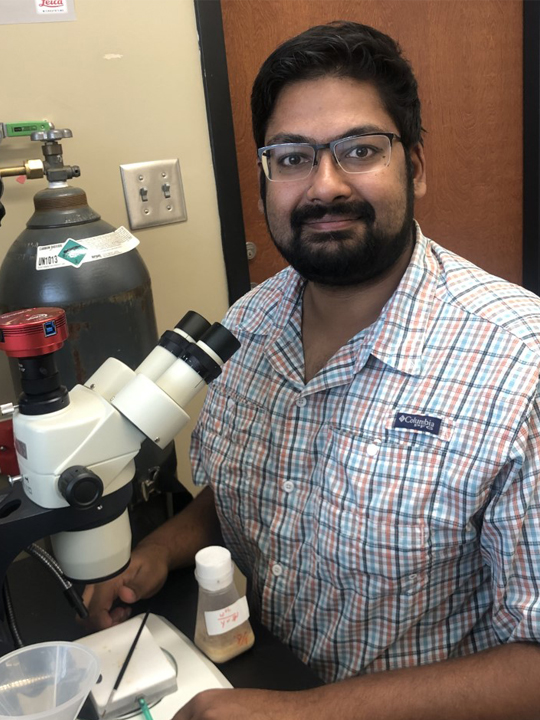Dr. Nicole Ackermans
Provide a brief synopsis of your education and research interests
My research involves the study of traumatic brain injury in headbutting animals like sheep as a model for humans. Very little is known how traumatic brain injury develops into chronic disease, by studying how it occurs in sheep over time due to their headbutting behaviors, we can develop a better understanding on how to reduce brain injury in humans.
What motivated you to pursue a career in science?
I have always loved animals and the outdoors. I didn’t want to do research at first, I imagined myself working at a zoo or in the rainforest. But the more I experienced research, the more I became addicted to discovering new things and answering my own questions about nature. I absolutely love my job, and it beats scooping poop at the zoo any day!
What about your area of research excites you the most?
Even though I have made my life more complicated by choosing to study animals like bighorn sheep and muskoxen, since they’re not easily found in a lab, I get to be the first person to find out things about their brains, and that feeling never gets old. The most exciting part is the potential to help patients suffering from TBI in the future.
What are the most challenging aspects of your research?
Research is mostly failure with some sprinkles of success. It’s just something that takes getting used to. Once you get over that, the most challenging is wearing all the hats that are part of being a researcher. We are required to be educators, public speakers, graphic designers, writers, engineers, MacGyver’s and much more. It takes a lot of organization.
What advice would you offer to undergraduate and graduate students?
Be flexible with your idea of where research will bring you, you might never expect to fall in love with the specific way a protein folds! It is important to take time to take care of your health or it will make you take time when it is most inconvenient!
Dr. Ed Burress
Provide a brief synopsis of your education and research interests
I received my BSc from a small liberal arts college in North Carolina (Lees McRae College), where I double majored in Biology and Psychology. From there I (literally) went over the mountain and earned my MSc at Appalachian State University. I later earned my Doctorate from Auburn University, then spent time as a postdoctoral researcher at the University of California at Davis and Yale University. I study functional morphology and how it related to ecology and performance. For example, most fishes have a second set of jaws in the back of their throat, the pharyngeal jaws, which functions in unison with the oral jaws as they eat. The oral jaws participate in prey capture, while the pharyngeal jaws do most prey processing. Many species, for example, have pharyngeal jaws with specialized teeth for crushing snail shells or grinding up plant matter and things like that. Different fishes have different arrangements of bones and muscles that operate the pharyngeal jaws, so I am also interested in comparing the functional morphology among different lineages to understand the ecological and evolutionary implications of their different configurations.
What motivated you to pursue a career in science?
I was interested in fish and salamanders, really any creature in or around streams, when I was young, but I don’t think the prospect of turning that interest into a career really took hold until the third year of undergraduate. A few of my undergraduate professors had a huge impact on me, cultivating my interest in science and math, either with encouragement here and there or opening a door instead of closing it. I got hooked on research almost immediately during graduate school and that sealed the deal so to speak.
What about your area of research excites you the most?
The field is advancing at a fast pace, especially in terms of statistical approaches. New comparative methods are developed every year and periodically make it possible to answer entirely new questions. That’s exciting and encourages creativity in anticipation of what will be possible in the future. More broadly, I’m most excited about mentoring and paying forward everything my advisors did for me along the way and developing my own mentoring and teaching philosophy.
What are the most challenging aspects of your research?
The necessity to stay up-to-date on the cutting edge of statistical and analytical methods. The pace of advancement as well as the breadth of the field can make that daunting.
What advice would you offer to undergraduate and graduate students?
Work with people that you enjoy working with and that actively foster your creativity, interests, and development. Academia is challenging in many ways and often involves ups and downs. Great colleagues and mentors make everything more enjoyable and fulfilling.
Dr. John Finger
Provide a brief synopsis of your education and research interests
I received a BS in Zoology from North Carolina State University in 2008. Throughout my BS, I worked at a reptile park in South Carolina, gaining a greater interest in reptiles, namely crocodilians. This led me to eventually pursue a PhD at the University of Georgia working with Dr. Travis Glenn. I had several projects during my PhD: influenza infection in reptiles, toxicant exposure in American alligators and yellow-bellied slider turtles, and agricultural production of saltwater crocodiles in Australia. I went on to pursue a postdoctoral fellowship at Auburn University investigating how the heat shock response and oxidative stress was affected by various stressors in zebra finches and alligators, working with Drs. Ruth Elsey and Mary Mendonca. Today, my research focuses on investigating a wide array of environmental disturbances and other stressors on disease/health of crocodilians and other reptiles, in both captive and open field experiments.
What motivated you to pursue a career in science?
Even while I was growing up, I have always been strongly motivated by my love for animals, especially reptiles, and knew as a child that I wanted to study them and work with them someday. Working with crocodilians literally got me through the stresses of a PhD just because I could not imagine working with anything else. However, on a more serious note, on both my paternal and maternal sides of the family, members of my family have had to suffer terrible rare protein misfolding diseases, including Lou Gehrig’s disease and amyloidosis, which has motivated me to learn more about physiological processes, including cellular pathways, genetics, and especially proteins. I work to incorporate studies of these broad topics of disease into non-model organisms as a foundation to gain more information that could be beneficial to both the organisms that I am working with as well as the medical field.
What about your area of research excites you the most?
Much of my research involves investigating toxicant exposure, human disturbance, or other stressors on the physiological processes of non-model organisms. I am excited at the opportunity to further investigate this at multiple levels of biological organization and the possible implications to human health.
What are the most challenging aspects of your research?
My answer to this question is twofold. First, although I have >15 years of experience, crocodilians can be dangerous, and consequently, complicate experiments. Moreover, their size, disposition, and habitat can hinder public perception for their conservation. Secondly, crocodilians are also considered to be non-model organisms in a research setting, so techniques that I use in my research usually must be adapted/validated for use, which can often be expensive and time-consuming.
What advice would you offer to undergraduate and graduate students?
Do not let anyone stop you from pursuing your dreams. In my time as a student, I have had to overcome many obstacles and many people that had little to no faith in my abilities to succeed in my dreams in life. People may not support your dreams or believe in them; people may even actively try to inhibit your dreams, but if you apply yourself, work hard, always do your best, and try not to get jaded with yourself and the world around you, opportunities will appear to keep you going in the direction that you want to go. Also, do not be afraid to ask questions or ask for help along the way when you really need it.
Dr. Pam Hart
Provide a brief synopsis of your education and research interests
I received my Ph.D. from Louisiana State University working in the LSU Museum of Natural Sciences. My Bachelor of Science in Marine Biology and my Master of Science are from Auburn University and the AU Museum of Natural History. I was awarded the National Science Foundation Postdoctoral Research Fellowship in Biology to work at the Sam Noble Museum of Natural History at the University of Oklahoma. I am interested in organismal adaptations to harsh environments, particularly related to darkness. My study systems are fish that live in caves and the deep-sea. I use genomics, behavior experiments, and evolutionary history to study how extremophiles thrive in their environments.
What motivated you to pursue a career in science?
My dad kept a fish tank when I was growing up and I became fascinated with the diversity of fishes. I joined the Learning about Science and Engineering Research club in high school and decided I loved research and wanted to continue learning about fish. Extremophile fish really drew me as they were so otherworldly, and it was interesting to me that different species of fish could invade the subterranean habitat and end up looking very similar (i.e., convergent evolution).
What about your area of research excites you the most?
What excites me about my area of research is the potential it has to make long-lasting impacts in biology but also public health. Cavefish are covered in sensory hair cells that feel the movement of the water around them. Inspiration in biotechnology was taken from these hair cells and used to create an intravenous (IV) flow sensor, which detects IV flow in humans. Thus, the system that I study can lead to breakthroughs in biotechnology directly related to human health.
What are the most challenging aspects of your research?
The most challenging aspects of my research are caving and coding- Coding may be the more challenging of the two! I did not come into biology with any background in computing or computer science and had to learn more about computers than I had ever imagined.
What advice would you offer to undergraduate and graduate students?
My advice is to follow your passion; find labs that suite your interests instead of the other way around.
Dr. Atulya Iyengar
Provide a brief synopsis of your education and research interests:
I’m a midwestern transplant. I did my BSE in biomedical engineering, BS in biology, and PhD in Neuroscience, and a post-doc in Neurogenetics all at the University of Iowa (with many external collaborators and side-trips guiding my trajectory). My broad research interests center on how genes interact with each other and with the environment to shape normal (or abnormal) nervous system function. We utilize the fruit fly, Drosophila melanogaster, as a model organism, and employ both classical and transgenic approaches to precisely manipulate the genome. In these single- and double-mutant flies, we correlate changes in neuronal structure and function with alterations in motor circuit activity patterns and the organization of behavioral repertoires. Findings from our work provide basic insights on the functional organization of the Drosophila nervous system and often have implications in understanding the etiology neurological disease.
What motivated you to pursue a career in science?
I grew up in a family that valued science. My dad was an engineer with John Deere, and growing up we would always great discussions about science in the news. When I was in high school, I had the opportunity to work in Chun-Fang Wu’s Drosophila Neurogenetics research lab at Iowa for a summer. Ever since, then I was hooked on neuroscience research.
What about your area of research excites you the most?
I’m really excited about combining emerging imaging approaches (e.g. genetically encoded Ca2+ sensors) with classical electrophysiological approaches to study how genes that affect synaptic transmission (e.g. neurotransmitter receptors) or neuronal excitability (e.g.. ion channels) lead to characteristic defects in motor program generation.
What are the most challenging aspects of your research?
Integrating phenomena across scales. Neurons synapse together to form neural circuits; activity in these circuits lead to an animal’s behavior. Often times, the tough questions in our field center on how do small changes in one level (e.g. a minor change in neurotransmitter release) link to catastrophic changes at another level (e.g. spontaneous seizures). Teasing apart these relationships can be quite tricky but is also immensely rewarding (at least it is to me!).
What advice would you offer to undergraduate and graduate students?
Take classes outside of your immediate needs or your comfort zone. A well-rounded course of study will prepare you for unexpected challenges in the future.
